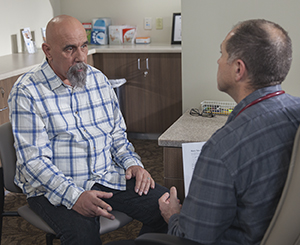Diagnosing Hemorrhoids
To diagnose hemorrhoids, your healthcare provider will rule out other problems and determine how bad your hemorrhoids are. After the evaluation, your provider will help you decide on a treatment plan that’s best for you.
Health history
A health history helps your healthcare provider learn more about your symptoms and overall health. This often includes questions about your bowel habits and diet. You may also be asked how often you exercise and if you take any medicines. Tell your provider if any members of your family have had cancer or polyps of the colon. It's also important to tell your provider if you're having any rectal bleeding.

Physical exam
During a physical exam, you’ll be asked to lie on an exam table. You’ll then be checked for signs of swollen hemorrhoids and other problems. The exam takes just a few minutes. It's usually not painful and may include:
-
Visual exam. This is done to view the outer anal skin. External hemorrhoids are always outside of the anal canal. They can be seen by just looking. Some internal hemorrhoids may also bulge or protrude out of the anal canal. These are also visible by just looking.
-
Digital rectal exam. This is used to check for hemorrhoids or other problems in the anal canal. It's done using a lubricated gloved finger.
-
Anoscopic exam. This is done using a short, clear plastic viewing tube called an anoscope. The scope helps your provider view the anal canal.
Grading hemorrhoids
Based on the physical exam, your healthcare provider may assign a grade to internal hemorrhoids. The grades are based on how bad your symptoms are:
-
Grade I hemorrhoids. These don't bulge or protrude from the anus. They may bleed, but otherwise cause few symptoms.
-
Grade II hemorrhoids. These protrude from the anus during bowel movements. They reduce back into the anal canal when straining stops.
-
Grade III hemorrhoids. These protrude on their own or with straining. They don't reduce by themselves. But they can be pushed back into place.
-
Grade IV hemorrhoids. These protrude and can't be reduced at all. They can also be painful and may need treatment right away.
Pregnancy and hemorrhoids
Many women get hemorrhoids during pregnancy and childbirth. This is likely caused by pressure on the pelvis and by hormonal changes. In most cases, the hemorrhoids will go away on their own over time. In the meantime, talk with your healthcare provider about ways to help ease your symptoms.
Other anal problems
Below are common problems that can cause symptoms similar to hemorrhoids:
-
Fissure. This is a small tear or crack in the lining of the anus. It can be caused by hard bowel movements, diarrhea, or inflammation in the rectal area. Fissures can bleed and cause painful bowel movements.
-
Abscess. This is an infected gland in the anal canal. The infected area swells and often causes pain.
-
Fistula. This is a pathway that may form when an anal abscess drains. The pathway may remain after the abscess is gone. Fistulas aren't often painful. But they can cause drainage where the pathway meets the skin.
Online Medical Reviewer:
Heather M Trevino BSN RNC
Online Medical Reviewer:
Rajadurai Samnishanth Researcher
Online Medical Reviewer:
Robyn Zercher FNP
Date Last Reviewed:
10/1/2024
© 2000-2024 The StayWell Company, LLC. All rights reserved. This information is not intended as a substitute for professional medical care. Always follow your healthcare professional's instructions.